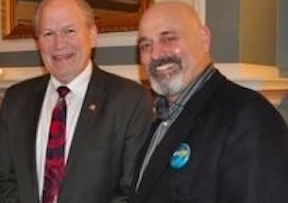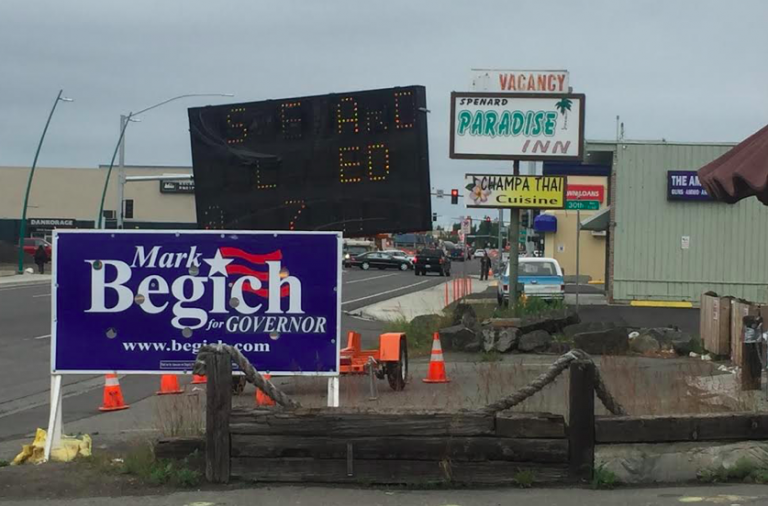THE PRESSURE IS BUILDING FOR BEGICH OR WALKER TO DROP
In an interview with KTOO-FM, the head of Alaska’s AFL-CIO says that Gov. Bill Walker deserves another term.
By their own poll, the AFL-CIO said this week that Walker and former Sen. Mark Begich are tied at 28 percent in the contest for governor.
But union President Vince Beltrami stopped short of endorsing Walker, because he wants one of the men to drop. He said a three-way race just won’t work for the goals of the union. He also has to wait for his membership to vote.
Beltrami said the governor deserves re-election but the AFL-CIO will make its official endorsement on Aug. 24 – if two-thirds of its unions can agree.
“If I had to make a bet, I would say that, if we can get an endorsement, if we can get two-thirds, that it would be more for Gov. Walker at this point, because folks believe that he’s earned re-election in our eyes,” Beltrami told the public broadcasting station.
In 2014, Beltrami told Walker and Byron Mallott that the union would sit on its hands — and its campaign money — until the two came up with a combination ticket, which they did by ditching their respective running mates.
With the agreement of the Alaska Democratic Party, they put former Republican (now undeclared) Walker at the top of their ticket, and the man whom Democrats had elected as their nominee, Democrat Byron Mallott, as lieutenant governor.
That combination won against sitting Gov. Sean Parnell, but they had to disenfranchise their primary voters to do so, reorganizing a more powerful ticket and ignoring what the primary voters had decided. The running mates who were ditched to make it possible? Craig Fleener and Hollis French. They received plum jobs from Walker, byt the way.
Beltrami is hoping to pull the same kind of power play again to reduce the likelihood of handing a victory to Republican Mike Dunleavy, the current Republican frontrunner.
The polling numbers that Beltrami released Monday tell him that either Walker or Begich has to yield the field.
Harstad Strategic Research, which conducted the poll, is a Colorado company that works for Democrats, most notably with Barack Obama. Harstad worked on behalf of the former president since 2002 and takes credit for a much of his electoral success. The company has also helped the fortunes of former Sens. Ken Salazar of Colorado, Tom Harkin of Iowa, Jack Reed of Rhode Island, Claire McCaskill of Missouri, Mark Udall of Colorado, and Gov. Tom Vilsack of Ohio. Here’s the company’s analysis of the Alaska governor’s race, based on its polling:
Harstad+Alaska+Survey+on+Governor’s+Race

AFL-CIO HAS STRONG INFLUENCE – BUT IS IT WANING?
Under Walker’s administration, and under the union presidency of Beltrami, the AFL-CIO has lost much of its private sector workforce, while the state workforce remains mostly intact. State workers are now Beltrami’s base.
But with the recent Janus decision, which Gov. Walker decried publicly, the union no longer can take money from government workers’ and retirees’ pockets without their permission.
Whether Beltrami has the political testosterone he had in 2014 remains to be seen in this post-Janus era.
Yet others are now involved in the full-court press to advance just one gubernatorial team from the Left.
Rep. Les Gara penned an appeal in the Anchorage Daily News to turn up the heat, and columnist Charles Wohlforth has opined that a three-way race hands the governorship to the Republicans, and that either Begich or Walker need to step off.
Walker said he’s sure the campaigns are talking to each other: “I anticipate there will be communications to a certain degree going forward and I think that’s probably a necessary piece to somewhat simplify the race to a two-way rather than a three-way,” he told KTOO.
That is far less than a resounding “No way am I dropping,” from Walker. But he already yielded the Democrats’ primary ballot to Begich, knowing he wasn’t strong enough to beat him in a two-way. Walker decided to go the petition route to the General Election, rather than face Begich in the primary.
It’s unheard of for a sitting governor to simply yield. Even Gov. Frank Murkowski stayed in the race, ending up with 18 percent of the primary vote against Sarah Palin and John Binkley. His prospects were poor, but he didn’t walk away. Governors (with the exception of a nationally-focused Sarah Palin) don’t just walk away.
But neither do Begiches, especially former sitting U.S. Sen. Begich, who is relatively young and intends to have a long political career.
Would either of these men take the back seat to the other?
The pressure is on, and although Republicans have a leading candidate for governor in Mike Dunleavy (with all polls showing him at the front of the pack), a lot of election shenanigans can happen between now and Sept. 2, when Democrats and Walker could craft another combo ticket to present to the voters.













